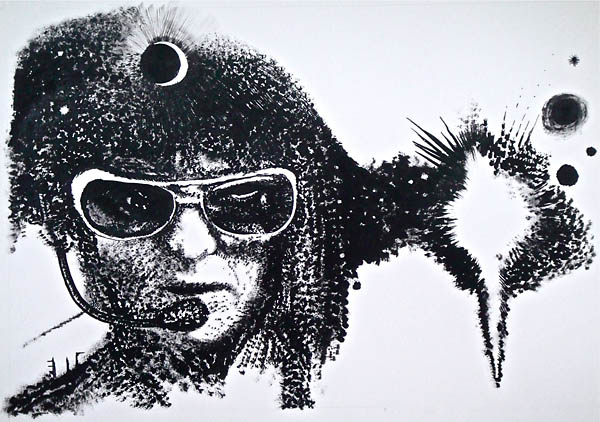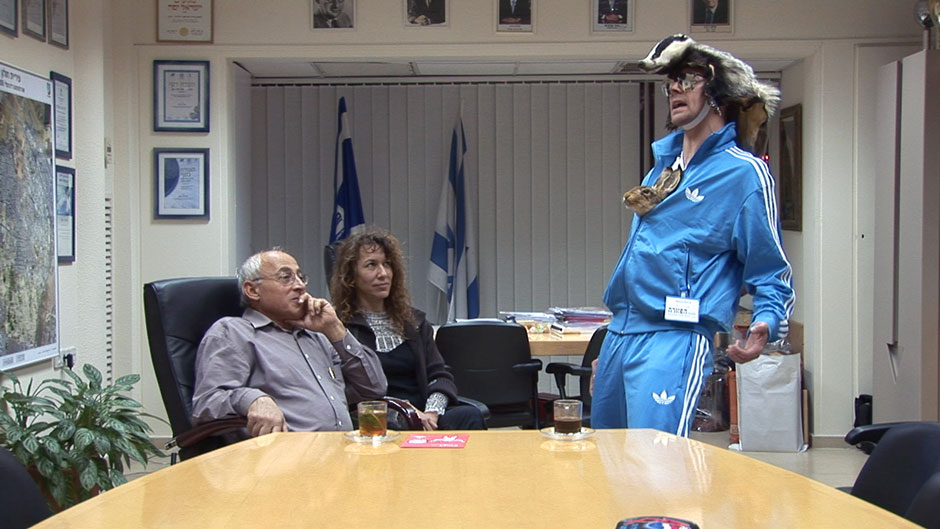
|
Lorna Mills and Sally McKay
Digital Media Tree this blog's archive OVVLvverk Lorna Mills: Artworks / Persona Volare / contact Sally McKay: GIFS / cv and contact |
View current page
...more recent posts
A few more notes on Adaptation at the Power Plant. Overall I liked the show (despite installation problems). Power Plant always does something big and broad and free in the summer, and animal/human interaction is not a bad theme for a blockbuster. I talked about Cory Arcangel's video the other day (fractious thread). I'd like to just mention a couple of other artworks that I really liked. FASTWURMS, Cat vs Dragon, 'meow',, 2010. ink on paper FASTWURMS based their installation on one of the best sci-fi short stories ever, "The Game of Rat and Dragon" by Cordwainer Smith. In the story, military human astronauts pair up with cats into telepathic teams that patrol the territory in outerspace to keep out "dragons." Each of the cats and humans have their own personalities, and some jive better than others. Our protagonist is kind of in love with one of the cats, and when they work together they make a killer team. FASTWURMS did fantastic black and white illustrations for the story and mounted them on the wall with the full text. In the age of ubiquitous cat imagery, FASTWURMS' cat art stands out because the cats aren't presented as ciphers for projections of human desire, but as powerful personalities in their own right . As witches, they take interspecies communication very seriously. But taking something seriously doesn't mean you can't have fun and kid around! Never cynical, but almost always ironic, these two know how to play with pop culture and sci-fi tropes to make strong assertions about the ways that humans and animals are entangled together with forces of nature/culture. The premise requires a suspension of disbelief on the part of the audiences, but FASTWURMS' love of kitsch makes that process easy.  video still from Marcus Coates' The Plover's Wing, A meeting with the mayor of Holon, Israel The British artist Marcus Coates also demands a suspension of disbelief as he channels animal spirits. In contrast to FASTWURMS, he really ramps up the uncomfortable tension between spoof and sincerity, making the suspension of disbelief a much more difficult decision. The video that impressed me the most was The Plover's Wing, A meeting with the mayor of Holon, Israel. Coates, wearing a dead badger on his head with a dead rabbit head poking out of the zipper on his track jacket, meets with the mayor of Holon. Through an interpreter, Coates offers his services as an animal spirit medium, and invites the mayor to ask him a question that has been bothering him. The mayor says he has a problem with youth violence in the city and he wants to figure out how to solve it as a means of working toward a less violent future in the Israel/Palestine conflict. Coates asks the mayor to move his chair back a little, and then goes into a long, loud trance, shaking and whooping, crouching and chirping and croaking. Playing the fool in some ways, he is also very convincing, demonstrating a performative depth of commitment to the exercise. He comes out of his trance eventually (to the apparent relief of the mayor and the interpreter, who is trying hard to keep a straight face), and calmly gives a quite cogent interpretation of his journey into the animal world. The mayor listens politely, and at the end offers feedback to the effect that he thinks Coates is sincere and not just playacting. I think so too. The video reminded me of Kristin Lucas performances where the artist inhabits a space that is difficult to accept. In the case of both Coates and Lucas, the work is much richer if the viewer can accept the terms as stated, and allow themselves into a suspension of disbelief, playing along with the artists' own commitment to the scenarios they present. Coates may be nuts, but I don't think he's scamming. And if he is, who cares? The concept is great, and better if you buy into it, at least for the duration of the performance. Both Coates and FASTWURMS push the limits of what audiences might normally accept as interspecies communication, tempting incredulity and teasing the realm of the supernatural. But both are also firmly rooted in the artworld, where paradoxical meanings have long been accepted. It's not necessary to make a definitive declaration that Coates is really channelling animal spirits, or thatFastwürms really communicate telepathically with cats. It's enough to respect the sincerity with which the artists propose the premise, and, at least temporarily, engage with the work on those terms. And interspecies communication is something well worth exploring these days, when social networks are fetishized as anonymous abstract structures in and of themselves, human brains are likened to computers rather than organisms, and climate change and species extinctions are sad and urgent facts of life. |